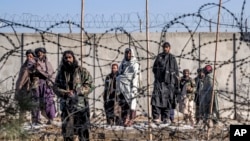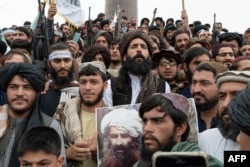On December 30, 2022, the Iranian president’s special envoy on Afghanistan affairs, Hassan Kazemi-Qomi, spun a conspiracy theory about the 20-year U.S. war in Afghanistan, which ended with the U.S. withdrawal in 2021.
Kazemi-Qomi said the fight against terrorism was only a pretext for the 2001 invasion.
“Their first excuse for choosing Afghanistan for the invasion was the existence of terrorism and al-Qaida while the group came to Afghanistan after the 9/11 attacks,” he said.
The envoy said the United States was pursuing its plans while al-Qaida was carrying out its assigned missions as a “proxy.”
“Americans brought Daesh to Afghanistan,” Kazemi-Qomi said, using an acronym for Islamic State, adding the U.S. sought to pursue its plans there through its occupation and its military presence.
"Iran's revisionist history claims that al-Qaida came to Afghanistan ‘after’ its cell attacked the U.S. mainland on 9/11 (from its terror bases located in eastern Afghanistan's Pashtun belt) are completely untethered from reality and patently false,” Brian Glyn Williams, author of “Counter Jihad. The American Military Experience in Afghanistan, Iraq and Syria,” told Polygraph.info.
The U.S. and its allies launched their invasion of Afghanistan with the goal of neutralizing al-Qaida and its co-founder, Osama bin Laden, who helped mastermind the September 11, 2001, terrorist attacks on the United States.
“The world knows that Osama bin Laden and his followers arrived in Taliban-controlled Afghanistan in 1996 after they were expelled from Sudan under joint U.S., Egyptian and Saudi pressure on the Turabi host government,” Williams said. He was referring to the-then government of Hassan al-Turabi in Sudan.
“In 1996, Taliban leader Mullah Omar granted bin Laden and al-Qaida melmastiia, or sanctuary, and bin Laden swore bayah (an oath of loyalty to Mullah Omar as the Commander of the Faithful) in 1998.”
From there, members of al-Qaida made their presence, and intentions against the U.S., known.
“Bin Laden and his No. 2, Ayman al Zawahiri, were regularly filmed by al-Qaida operatives and interviewed in their Afghan bases at Khalden, and Al Farouq, by the world media from 1996 to 2001. For example, in 1996, ‘97 and ‘98, bin Laden issued his infamous televised ‘fatwas’ or decrees calling for attacks on the American ‘Far Enemy’ from his terror camps in eastern Afghanistan,” Williams said.
He added that the 9/11 hijackers were also filmed at al-Qaida bases in Afghanistan prior to the attacks.
In October 1999, the U.N. Security Council adopted Resolution 1267, creating the so-called al-Qaida and Taliban Sanctions Committee.
That resolution linked "the two groups as terrorist entities" and imposed "sanctions on their funding, travel, and arms shipments,” the Council on Foreign Relations said.
The measure also called on the Taliban to hand over bin Laden to the “appropriate authorities.” Bin Laden had been indicted by the U.S. earlier that year for conspiring to kill U.S. citizens.
Al-Qaida has been implicated in a number of terrorist attacks targeting the U.S., including the 1998 U.S. embassy bombings in Nairobi, Kenya, and Dar Es Salaam, Tanzania, which killed 224 people and injured 4,500 others.
The Taliban also provided al-Qaida with a base that it used to organize the 9/11 attacks, which killed nearly 3,000 people on U.S. soil.
Prior to the invasion of Afghanistan in October 2001, the U.S. and the U.N. Security Council demanded that the Taliban hand over bin Laden.
The Taliban put forward conditions for handing bin Laden over to a “third country,” which the U.S. rejected.
While the U.S. quickly toppled the Taliban, two decades of insurgency and reconstruction efforts followed. The U.S. ultimately signed a peace deal with the Taliban in February 2020.
Williams said Iran’s “absurd” claim that the U.S. is carrying out its plans in Afghanistan using al-Qaida as a “proxy” shows a poorly informed view “on the geopolitics of countries on their own borders.”
“The fact is that the U.S.-led war effort in Afghanistan, known as Operation Enduring Freedom, ended in 2014 and the last remaining 2,000 ‘light footprint’ support troops, who were supporting Afghan National Army troops as part of Operation Resolute Support, were disastrously withdrawn from Afghanistan in August 2021. There is no U.S. ‘occupation’ of Afghanistan, that job now belongs to the Taliban,” he said.
In August 2021, the Special Inspector General for Afghanistan Reconstruction, the U.S. government's leading oversight authority on Afghanistan reconstruction, released a report that raised critical questions about the U.S. mission there.
Still, claims that al-Qaida is a U.S. proxy are belied by successful efforts to weaken the terror group.
As noted in a report from the Brookings Institution research group in Washington, D.C. noted:
“Although al-Qaida has fighters in Afghanistan, its ability to launch international terrorist attacks from there and from Pakistan, where the core organization has been based for almost 20 years, is limited. Al-Qaida core members haven’t successfully attacked the U.S. homeland since 9/11, despite numerous attempts, and have also been ineffective against Europe in the past decade.”
The U.S. has also eliminated top-ranking al-Qaida members.
“It seems the Iranian Press TV did not get the news that the American CIA killed al-Qaida leader Ayman al- Zawahiri, who was living in Taliban- controlled Kabul in direct contradiction of a Taliban agreement with the U.S., with a so-called Predator drone ‘Ninja bomb’ strike on his home in August 2022. Hardly the sort of treatment a country metes out to ‘proxies’ it ‘assigns missions to,’” Williams said.
The U.S. killed bin Laden a decade earlier - at a compound in Abbottabad, Pakistan, on May 2, 2011.
Outside of Afghanistan, the U.S. also successfully (and controversially) killed Anwar al-Awlaki, a U.S. citizen who served as an al-Qaida spokesperson, and Abu Yahya al-Libi, another top al-Qaida leader.
An April 2022 report by the U.N.’s monitoring team in Afghanistan said, "The relationship between the Taliban and al-Qaida remains close.”
That report added that member state assessments suggest al-Qaida “has a safe haven under the Taliban and increased freedom of action.”
As for Islamic State, Polygraph.info has previously debunked similar Russian disinformation attempting to link the U.S. to the militant group’s branch in Afghanistan, called Islamic State – Khorasan Province (ISIS-K).
The actual history of combat between the U.S. and Islamic State, including longtime U.S. efforts to eradicate ISIS-K and its leadership in Afghanistan, are well-documented.







